Plastic extruder
In plastic extrusion molding equipment, the plastic extruder is usually referred to as the main machine, while the subsequent equipment that is matched with it, the plastic extrusion molding machine, is called the auxiliary machine. After more than 100 years of development, plastic extruders have evolved from single screw to various models such as twin-screw, multi screw, and even no screw. The plastic extruder (host) can be matched with various plastic molding auxiliary machines such as pipes, films, rods, monofilaments, flat wires, packing belts, extruded nets, plates (sheets), profiles, granulation, cable wrapping, etc., to form various plastic extrusion molding production lines and produce various plastic products. Therefore, plastic extrusion molding machinery is one of the widely used models in the plastic processing industry, both now and in the future.
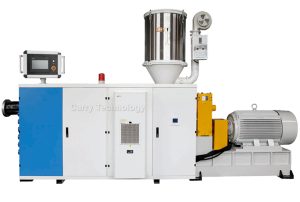
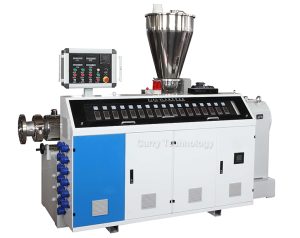
Plastic extruder machine composition structure
The main unit of a plastic extruder is the extruder, which consists of an extrusion system, a transmission system, and a heating and cooling system.
Extruding system
The extrusion system includes a screw, barrel, hopper, head, and mold. Plastic is plasticized into a uniform melt through the extrusion system, and under the pressure established during this process, it is continuously extruded by the screw head.
1) Screw: It is the most important component of the extruder, which directly affects the application range and productivity of the extruder. It is made of high-strength and corrosion-resistant alloy steel.
2) Barrel: It is a metal cylinder, generally made of alloy steel or composite steel pipes lined with alloy steel with high heat resistance, pressure resistance, durability, wear resistance, and corrosion resistance. The combination of the barrel and screw achieves the crushing, softening, melting, plasticizing, venting, and compaction of plastics, and continuously and uniformly delivers the rubber material to the molding system. The length of the general barrel is 15-30 times its diameter, in order to ensure that the plastic is fully heated and plasticized.
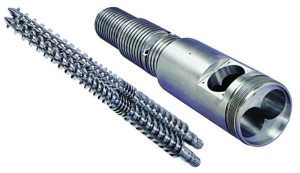
3) Hopper: The bottom of the hopper is equipped with a cutoff device for adjusting and cutting off the material flow, and the side of the hopper is equipped with a sight hole and a calibration measuring device.
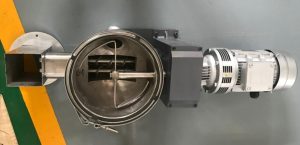
4) Machine head and mold: The machine head is composed of an alloy steel inner sleeve and a carbon steel outer sleeve. The machine head is equipped with a forming mold, and its function is to convert the rotating plastic melt into parallel linear motion, uniformly and smoothly introduce it into the mold sleeve, and give the plastic the necessary forming pressure. Plastic is plasticized and compacted inside the barrel, and flows through a porous filter plate along a certain channel through the neck of the machine head into the forming mold. The mold core and sleeve are appropriately matched to form a circular gap with a continuously decreasing cross-section, allowing the plastic melt to form a continuous and dense tubular coating layer around the core wire. To ensure a reasonable plastic flow channel inside the machine head and eliminate dead corners where plastic accumulates, diversion sleeves are often installed. To eliminate pressure fluctuations during plastic extrusion, pressure equalization rings are also installed. The machine head is also equipped with a device for mold calibration and adjustment, which facilitates the adjustment and correction of the concentricity of the mold core and sleeve.
The extruder is divided into angled heads (with an angle of 120 degrees) and right angled heads according to the direction of the material flow at the head and the centerline of the screw. The outer shell of the machine head is fixed to the body with bolts. The mold inside the machine head has a core seat and is fixed to the wire inlet port of the machine head with a nut. The front of the core seat is equipped with a core, and the center of the core and the core seat has a hole for passing the core wire. A pressure equalization ring is installed at the front of the machine head to balance the pressure. The extrusion molding part is composed of a mold sleeve seat and a mold sleeve. The position of the mold sleeve can be adjusted by bolts through support to adjust the relative position of the mold sleeve to the mold core, which is convenient for adjusting the uniformity of the extrusion layer thickness. The outside of the machine head is equipped with heating and temperature measurement devices.
Drive system
The function of the transmission system is to drive the screw and supply the torque and speed required by the screw during the extrusion process. It usually consists of an electric motor, a reducer, and bearings.
Under the premise of basically the same structure, the manufacturing cost of the reducer is roughly proportional to its external dimensions and weight. Due to the large shape and weight of the gearbox, it means that more materials are consumed during manufacturing, and the bearings used are also relatively large, which increases the manufacturing cost.
For extruders with the same screw diameter, high-speed and efficient extruders consume more energy than conventional extruders. It is necessary to increase the motor power by twice and correspondingly increase the base size of the reducer. But high screw speed means low reduction ratio. For reducers of the same size, compared to those with a large reduction ratio, those with a low reduction ratio have an increased gear module, which increases the ability of the reducer to withstand loads. Therefore, the increase in volume and weight of the reducer is not linearly proportional to the increase in motor power. If the extrusion volume is used as the denominator and divided by the weight of the reducer, the high-speed and efficient extruder will have a smaller number, while the ordinary extruder will have a larger number.
In terms of unit output, the motor power and reducer weight of high-speed and efficient extruders are small, which means that the manufacturing cost of high-speed and efficient extruders per unit output is lower than that of ordinary extruders.
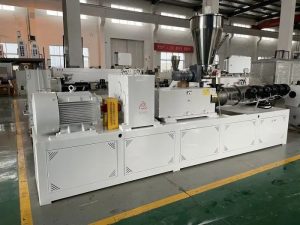
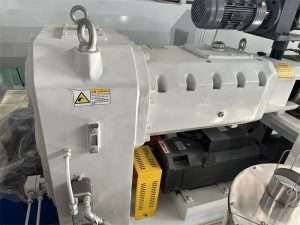
Heating and cooling device
Heating and cooling are necessary conditions for the plastic extrusion process to proceed.
1) The extruder usually uses electric heating, which is divided into resistance heating and induction heating. The heating element is installed in the body, neck, and head of the machine. The heating device heats the plastic inside the external heating cylinder to achieve the temperature required for process operation.
2) The cooling device is set up to ensure that the plastic is within the temperature range required by the process. Specifically, it is to eliminate the excess heat generated by the shear friction of the screw rotation, in order to avoid excessive temperature that may cause plastic decomposition, burning, or difficulty in shaping. Barrel cooling can be divided into two types: water-cooled and air-cooled. Generally, air-cooled is more suitable for small and medium-sized extruders, while water-cooled or a combination of both forms of cooling are more commonly used for large extruders; Screw cooling mainly adopts central water cooling, aiming to increase the solid material conveying rate, stabilize the adhesive output, and improve product quality; But the cooling at the hopper is to strengthen the conveying effect of solid materials, prevent plastic particles from sticking and blocking the material mouth due to temperature rise, and ensure the normal operation of the transmission part.
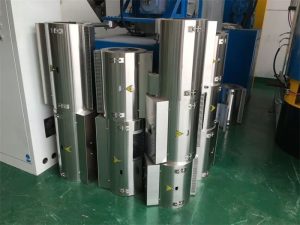
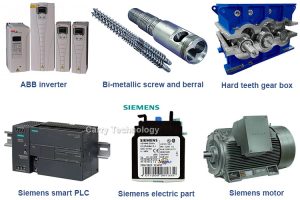
Zhangjiagang Carry Technology Co., Ltd. provides stable performance, high-quality and cost-effective plastic twin-screw/single-screw extruders and related PVC HDPE PP products extrusion production lines for customers to choose from, welcome to consult.
